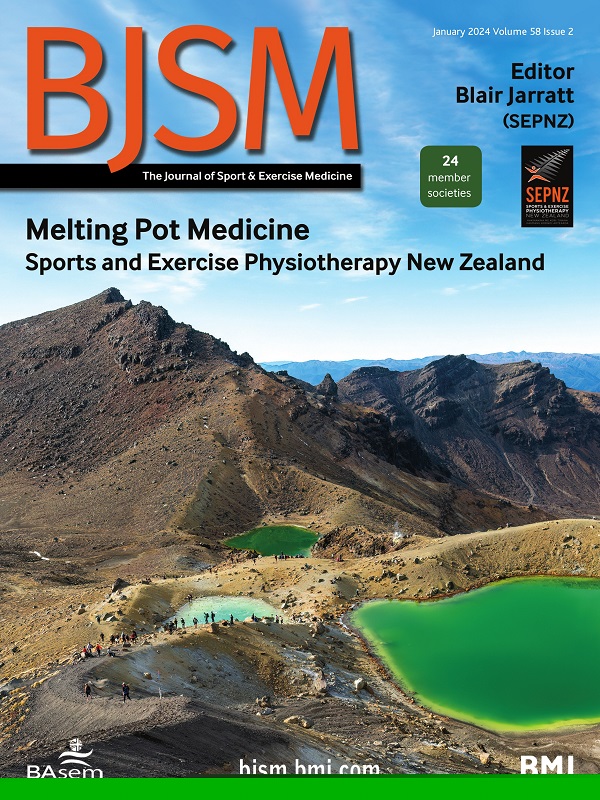Exercise parameters to consider for Achilles tendinopathy: a modified Delphi study with international experts
IF 16.2
1区 医学
Q1 SPORT SCIENCES
引用次数: 0
Abstract
To assess the level of agreement among experts on the heel raise exercise parameters that influence midportion and insertional Achilles tendinopathy (AT) rehabilitation outcomes. An international expert panel in AT rehabilitation was invited to complete a three-round Delphi survey. In the first two rounds, experts were asked to review a pregenerated list of exercise parameters (based on the heel raise exercise) and rate their perceived influence on rehabilitation outcome, using a 5-point Likert scale. For each parameter, consensus criteria for major influence on rehabilitation were (a) median≥4, (b) ≥75% of scoring 4 or 5 and (c) IQR≤1. The third round aimed to rank the exercise parameters according to importance (from most to least important) during rehabilitation. 17 experts participated in the entire Delphi process. A total of 16 exercise parameters were assessed, of which 4 (intensity of contraction, total time under tension, number of repetitions and sets, type of contraction) reached consensus as having a major influence on rehabilitation for midportion AT and 3 reached consensus for insertional AT (range of ankle dorsiflexion during the exercise, intensity of contraction, number of repetitions and sets). The rankings of parameters that reached consensus showed that contraction intensity was perceived as the most important variable for midportion AT rehabilitation, while range of ankle dorsiflexion was deemed the most important variable for insertional AT rehabilitation. This study identified key exercise parameters for mid-portion and insertional AT rehabilitation based on expert opinion. This information should assist practitioners in optimising their approach to deliver more effective, patient-specific exercises for AT rehabilitation.考虑跟腱病变的运动参数:与国际专家的改良德尔菲研究
为了评估专家对影响中部和插入性跟腱病(AT)康复结果的足跟运动参数的一致程度。邀请了一个AT康复方面的国际专家小组完成三轮德尔菲调查。在前两轮中,专家们被要求回顾预先生成的运动参数列表(基于脚跟抬高运动),并使用5分李克特量表评估它们对康复结果的感知影响。对于每个参数,对康复的主要影响的共识标准是(a)中位数≥4,(b)评分为4或5的≥75%,(c) IQR≤1。第三轮的目的是根据康复过程中运动参数的重要性(从最重要到最不重要)进行排序。17位专家参与了整个德尔菲过程。共评估了16项运动参数,其中4项(收缩强度、总张力时间、重复次数和组数、收缩类型)被认为是对中段AT康复的主要影响因素,3项(运动时踝关节背屈范围、收缩强度、重复次数和组数)被认为是对插入式AT康复的主要影响因素。对达成共识的参数排序显示,收缩强度被认为是中位AT康复最重要的变量,而踝关节背屈度被认为是插入式AT康复最重要的变量。本研究根据专家意见确定了中间部分和插入式AT康复的关键运动参数。这些信息应该有助于从业者优化他们的方法,为AT康复提供更有效的、针对患者的练习。
本文章由计算机程序翻译,如有差异,请以英文原文为准。
求助全文
约1分钟内获得全文
求助全文
来源期刊
CiteScore
27.10
自引率
4.90%
发文量
217
审稿时长
3-8 weeks
期刊介绍:
The British Journal of Sports Medicine (BJSM) is a dynamic platform that presents groundbreaking research, thought-provoking reviews, and meaningful discussions on sport and exercise medicine. Our focus encompasses various clinically-relevant aspects such as physiotherapy, physical therapy, and rehabilitation. With an aim to foster innovation, education, and knowledge translation, we strive to bridge the gap between research and practical implementation in the field. Our multi-media approach, including web, print, video, and audio resources, along with our active presence on social media, connects a global community of healthcare professionals dedicated to treating active individuals.

 求助内容:
求助内容: 应助结果提醒方式:
应助结果提醒方式:


